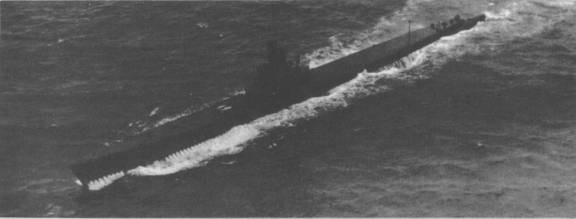Cavalla (SS-244)

(SS-244: dp. 1,526; l. 311'9"_... b. 27'3"; dr. 15'3"; s. 20 k.; cpl. 60; a. 1 3", 10 21" tt.; cl. Gato)
A salt water fish of the pompano family inhabiting waters off the eastern coast of the Americas from Cape Cod to Rio de la Plata.
Cavalla (SS-244) was launched 14 November 1943 by Electric Boat Co., Groton, Conn.; sponsored by Mrs. M. Comstock; and commissioned 29 February 1944, Lieutenant Commander H. J. Kossler in command.
Departing New London 11 April 1944, Cavalla arrived at Pearl Harbor 9 May for voyage repairs and training. On 31 May 1944 she put to sea, bound for distant, enemy-held waters.
It was on her maiden patrol that Cavalla rendered the distinguished service that earned her a Presidential Unit Citation. En route to her station in the eastern Philippines, she made contact with a large Japanese task force 17 June 1944. Cavalla tracked the force for several hours, then relayed invaluable information which contributed heavily to the overwhelming United States victory scored in the Battle of the Philippine Sea-the famous "Marianas Turkey Shoot" on 19-20 June 1944. With this great service completed, Cavalla continued her pursuit. On 19 June she caught the carrier Shokaku landing planes and quickly fired a spread of six torpedoes for three hits, enough to send Shokaku to the bottom in 11-50' N., 137-57' E. After a severe depth charging by three destroyers, Cavalla escaped to continue her patrol.
Cavalla's second patrol took her to the Philippine Sea as a member of a wolfpack operating in support of the invasion of Peleliu 15 September 1944.
On 25 November 1944 during her third patrol, Cavalla encountered two Japanese destroyers, and made a daring surface attack which blew up Shimotsuki in 02-21' N., 107- 20' E. The companion destroyer began depth charg- ing while elusive Cavalla evaded on the surface. Later in the same patrol, 5 January 1945, she made a night surface attack on an enemy convoy, and sank two converted net tenders in 05-00' S., 112-20' E.
Cavalla cruised the South China and Java Seas on her fourth and fifth war patrols. Targets were few and far between, but she came to the aid of an ally on 21 May 1945. A month out on her fifth patrol, the submarine sighted HM Submarine Terrapin, damaged by enemy depth charges and unable to submerge or make full speed. Cavalla stood by the wounded submarine and escorted her on the surface to Fremantle, arriving 27 May 1945.
Cavalla received the cease-fire order of 15 August while lifeguarding off Japan on her sixth war patrol. A few minutes later she was bombed by a Japanese plane that apparently had not yet received the same information. She joined the fleet units entering Tokyo Bay 31 August, remained for the signing of the surrender on 2 September, then departed the next day for New London, arriving 6 October 1945. She was placed out of commission in reserve there 16 March 1946.
Recommissioned 10 April 1951, Cavalla was assigned to Submarine Squadron 8 and engaged in various fleet exercises in the Caribbean and off Nova Scotia. She was placed out of commission 3 September 1952 and entered Electric Boat Co. yard for conversion to a hunter-killer submarine (reclassified SSK-244, 18 February 1953).
Cavalla was recommissioned 15 July 1953 and assigned to Submarine Squadron 10. Her new sonar made Cavalla valuable for experimentation and she was transferred to Submarine Development Group 2 on 1 January 1954, to evaluate new weapons and equipment, and participate in fleet exercises. She also cruised to European waters several times to take part in North Atlantic Treaty Organization exercises, and visited Norfolk, Va., for the International Naval Review (11-12 June 1957). She remained active with the Fleet through 1963; on 15 August 1959, her classification reverted to SS-244.
In addition to the Presidential Unit Citation, Cavalla received four battle stars for service in World War II. Of her six war patrols, the first and third were designated as Successful War Patrols. She is credited with having sunk a total of 34,180 tons of shipping.


